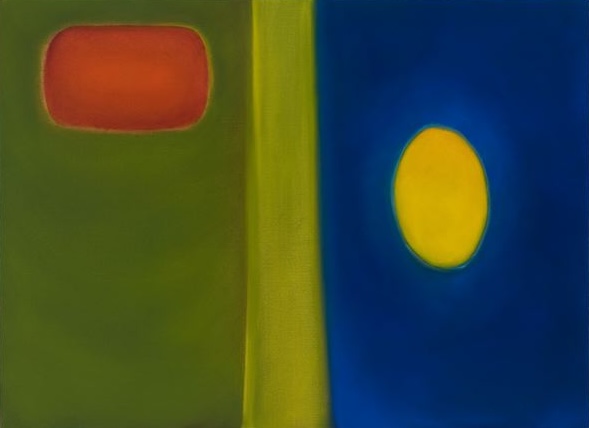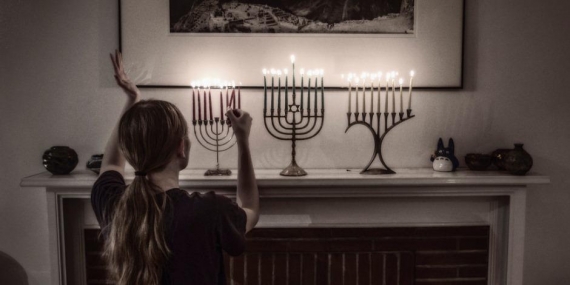A summary of facts, characters, and holidays pertaining to the month of Tishrei
This “Essence” is taken from the Sourcebook for Leaders, written by Rabbi Rachel Gartner and Barbara Berley Melits, for Rosh Hodesh: It’s a Girl Thing! This experiential program was created by Kolot: The Center for Jewish Women’s and Gender Studies to strengthen the Jewish identity and self-esteem of adolescent girls through monthly celebrations of the New Moon festival. The program is now available through Moving Traditions.
Fast Facts
Tishrei is the seventh of the twelve months of the Jewish calendar. It is always 30 days.
Tishrei coincides with the secular months September/October.
Tishrei contains the fall equinox. We begin to seek an inner balance that reflects the equilibrium between day and night. As the seasons change from summer to fall, we too seek changes in our lives. We hope that our journey is also colorful and bright.
The mazal (constellation) for Tishrei is a pair of scales, symbolizing scales of justice. The zodiac sign is Libra.
Tishrei overflows with holy days which usher in the Jewish New Year. The four main holidays of Tishrei correspond to the four phases of the moon.1
Festivities
Rosh HaShanah (The New Year) is observed on Rosh Hodesh Tishrei. The Torah refers to Rosh HaShanah as Yom Teruah (The Day of Sounding the Shofar) or Yom HaZikaron (The Day of Remembering). It was not called Rosh HaShanah until talmudic times. Many Reform communities celebrate Rosh HaShanah for one day only. It is the only holiday that Israeli Jews celebrate for two days. Rosh HaShanah marks the anniversary of the creation of the world.
Rosh HaShanah
Shofar. Reflected in one of the names of the Holy Day (Yom Teruah), the shofar is blown 100 times on each day of Rosh HaShanah. One of many traditions suggests that the shofar blasts represent Sarah’s cries when she learned that Abraham had set out to sacrifice Isaac. Sarah’s cries recall women’s cries for justice for themselves and for their families throughout history and all over the world. The shofar calls all Jews together and stirs each soul to repentance.
Tashlich. (You will cast away). In this context, tashlich refers to a custom dating from at least as early as the fourteenth century, based on the last verses of the Book of Micah: “And You will cast into the depths of the sea all their sins” (7:19). Consequently, Jewish communities have for many generations gathered by rivers, streams, or oceans on the first day of Rosh HaShanah, recited tashlich prayers, and thrown bread crumbs into the water to symbolize our desire to rid ourselves of our sins. Kurdish Jews actually threw themselves into the water for tashlich! Hasidim of Galicia sent straw floats out into the water, used candles to set them on fire, and rejoiced as they burned up or washed away.2
Tzom Gedaliah (Fast of Gedaliah), observed on Tishrei 3, is an annual fast to commemorate the assassination of Gedaliah Ben Achikam, the Governor of Israel during the last days of Judean semi-autonomy before Jews were driven into final exile by the Babylonians.
Aseret Yamei Teshuvah (Ten Days of Repentance) are observed between Rosh HaShanah and Yom Kippur. The special character of these days manifests itself in emphasis on teshuvah, (turning our backs on what is worst in ourselves and embracing what is best), tefillah (prayer), and tzedakah (acts of justice/charity).
Yom Kippur (Day of Atonement) is observed on Tishrei 10, as the moon swells. Yom Kippur is meant to bring Jews closer to a sense of God in our lives and to inspire us to bring out what is best in ourselves through the process of teshuvah.
Yom Kippur Customs
Fasting, as well as the other abstentions observed on this day, is meant to guide our thoughts away from our physical needs and help focus our minds on spiritual growth and teshuvah. Tradition urges that this fast should also remind us of those who lack basic sustenance. Many communities donate the amount of money they would have spent to feed themselves on Yom Kippur to organizations that feed the hungry. (Please note that pregnant women, the infirm, or anyone who might be harmed by doing so are prohibited from fasting.)
Refraining from wearing leather, one of the other five traditional abstentions for Yom Kippur, is meant to guide us away from materialism as leather is considered to be a sign of luxury.
Sukkot (Booths) begins on the full moon of Tishrei 15 and continues through Tishrei 21. Sukkot comes just five days after Yom Kippur. Only after we have accomplished the challenging spiritual work of Yom Kippur, can we be truly joyous on Sukkot. Indeed, there is a special mitzvah of simcha (happiness), on Sukkot. Sukkot commemorates how protective clouds surrounded the Jewish people during the forty years of wandering in the desert. It also commemorates how the Jews lived in temporary dwellings (sukkot) during that same time.
Sukkot Customs
Welcoming Guests. Today we decorate our sukkot and it is customary to invite our ancestors symbolically to join us for a meal! “According to the mystical text the Zohar, “when you sit in the sukkah … the Shechina (God’s feminine indwelling presence) spreads its wings over you and…. Abraham, five other righteous ones, and King David, make their dwelling with you…Thus you should rejoice with a shining countenance each and every day of the festival together with these guests who lodge with you…” (Zohar Emor, 103b).
From this verse, Jewish mystics in the sixteenth century popularized the custom of symbolically inviting seven biblical characters as ushpizin (guests) into their sukkot over the seven nights of the holiday… Traditions inviting biblical women, or ushpizot (plural feminine of ushpizin), into the sukkah also exist. According to sixteenth-century mystic Manachem Azariah, known as the Ramah of Fano, the seven female figures to welcome are the seven prophetesses: Sarah, Miriam, Devorah, Hannah, Avigail, Huldah, and Esther. Other traditions include Rebecca, Rachel and Leah.”3
Hoshana Rabbah, observed on Tishrei 21, is the seventh and last day of Sukkot. Hoshana Rabbah is known as the day of the final sealing of judgment, which began on Rosh HaShanah.
Shmini Atzeret, observed on Tishrei 22 as the moon wanes, begins the period in the year in which we add to our regular liturgy a special prayer praising God as the Source of the blessing of rain.
Simchat Torah is observed on Tishrei 23 in some Jewish communities in the Diaspora and on Tishrei 22 in Israel and some Reform and Reconstructionist communities. Simchat Torah celebrates the completion and the beginning of the annual cycle of Torah readings. On the night preceding Simchat Torah, and again in the morning, Jews all over the world dance joyously with the Torah.
Foods
Rosh HaShanah
In addition to eating apples and hallah dipped in honey for a sweet new year, there are numerous lesser-known and quite extraordinary food customs for Rosh HaShanah. The following foods are eaten as simanim (good omens) of success and happiness for the coming year. Try inventing and serving your own!
The head of a fish, for we should always be “on top” like a head, and not “on the bottom.”
Pomegranates, for we want to be as full of good deeds as the pomegranate is full of seeds.
Carrots, because, in Yiddish, the word for carrots is merren which sounds like the Yiddish word that means “more.” We want to have more blessings, more knowledge, give more charity and perform more good deeds in the coming year.
Pumpkin phyllo rounds. Scholar Ruth Abusch-Magder explains that though spelled differently, the Hebrew word for pumpkin sounds the same as the verb “to rip.” Thus, for Rosh HaShanah Jewish women from North Africa and the Levant prepare “snail shaped pastries filled with sweetly spiced pumpkin… as a tasty start to a meal and an inducement for God to tear out the pages from our book of sins, allowing us to continue sweetly in the round circle of life.”4
Fabulous Females
The High Holy Day torah portions for communities that celebrate Rosh HaShanah for two days are Genesis 21 and 22. The haftarot are I Samuel 1:1-2:10 on the first day and Jeremiah 31:1-19 on the second. Some Reform communities that celebrate Rosh HaShanah for one day read Genesis 1 focusing on the theme of creation. We meet the following biblical women in these parshiot:
Sarah is the first matriarch of the Jewish people. She is celebrated for her courage in leaving her homeland for an unknown future, her beauty, her hospitality, her laughter and ability to rejoice at hearing she would have a child at the mature age of 90.
Sarah reminds us to honor the wisdom, struggles, creativity, and joys of our women elders.
Hagar is an Egyptian woman who became Sarah’s handmaiden and Abraham’s concubine. She is the mother of Ishmael and hence the grandmother of the Ishmaelites or Arabs. Once, Hagar fled into the desert, escaping from Sarah’s mistreatment. There, Hagar spoke of God in intimate terms calling God, El Roi, “The One Who Sees Me.” Later, Hagar’s eyes were opened to God’s blessings as she found a well from which to give her thirsty son water.
Hagar reminds us to honor our shared ancestry with Arabs. She calls upon us to show solidarity with women and girls who are denied power, whose voices are silenced, and whose strengths are many and often unacknowledged.
Lilith first appears in Jewish tradition in midrashic literature. The two accounts of the creation story (one in Genesis 1, the other in Genesis 2) prompted the rabbis to teach that these stories reflect the creation of two different women, the first Lilith, the second Eve. According to tradition, since Lilith was created in God’s image simultaneously with Adam (Genesis 1), she asserted her equality with him. When Adam refused to recognize Lilith’s claims, Lilith left the Garden of Eden for eternity. The legend of Lilith has been expanded upon and transformed over centuries. Although Lilith is often demonized in these traditions, today Jewish women celebrate her for her bold, independent spirit.
Lilith reminds us to celebrate our individuality, to find ways to enhance women’s status in Jewish life, and to fight for equality for women world-wide.
Eve, whose name means life, is the first woman in the Bible, and the mother of life. That she cherished her role as procreator is suggested by her speech upon the birth of her first child: “I have gained a child with the help of the Lord” (Genesis 4). God only tells Adam that he cannot eat from the tree, and scholar Ellen Frankel challenges us to imagine how different the story might have been if God had spoken to Eve directly. Today women celebrate Eve for her curiosity and passionate pursuit of knowledge.
Eve reminds us to love and respect life, to accept the consequences of our choices, and to make the best of our fate.
Hannah is one of two co-wives to a man named Elkanah. Stricken with grief over her inability to bear children, Hannah “pours her soul out to God” in prayer. After finally giving birth, Hannah offers a song of praise to God. The rabbis admire Hannah for heart-felt sincerity of her prayer and hold her up as a model of piety. Today we also admire her for the self-knowledge and courage to identify and ask for what she wanted.
Hannah reminds us to pursue our passions and goals with all of our heart, soul, and might. Her story exemplifies the power of speaking what’s in our heart.
Peninah, Hannah’s (see above) co-wife, bore two sons to Elkanah. Peninah taunted the barren Hannah, whom she watched receive double portions of Elkanah’s gifts and perhaps of his love as well.
Peninah invites our compassion and empathy even as we wish that she had appreciated her own blessings and avoided jealously.
————————-












